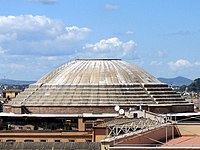
Photo from wikipedia
Abstract In order to promote the construction of “sponge city”, fully utilize industrial solid waste, an eco-friendly permeable ceramic was successfully prepared by using silica sand tailing, steel slag and… Click to show full abstract
Abstract In order to promote the construction of “sponge city”, fully utilize industrial solid waste, an eco-friendly permeable ceramic was successfully prepared by using silica sand tailing, steel slag and coal gangue. Through systematic investigation of water permeability, density, compressive strength, bending strength and chemical stability to study the effects of composition and sintering temperature changes on its properties. Its pore-forming mechanism was mainly researched by XRD, SEM and phase diagram analysis. Research indicates: As the content of silica sand tailing increases, the permeable ceramic structure becomes denser and the pores decrease. The best composition formula is silica sand tailing 55 wt%-steel slag 20 wt%-coal gangue 25 wt% (water permeability 4.68 × 10−2 cm/s, compressive strength 42.83 MPa, bending strength 6.87 MPa); with sintering temperature increasing, the permeable ceramic structure becomes porous, the optimum sintering temperature range is 1150 °C–1170 °C (water permeability 4.11 × 10−2 cm/s–4.96 × 10−2 cm/s, compressive strength 40.15 MPa–45.41 MPa, bending strength 6.26 MPa–7.88 MPa). Maintaining good chemical stability in both composition and sintering temperature change, and their permeability is far beyond the Chinese standard (1 × 10−2 cm/s). The pore formation is mainly attributed to the fact that the O2 released by the decomposition of Fe2O3 is coated by the formed glass liquid phase (Ca-Fe-Si-Mg-Al-O system) and flowing, then ruptures everywhere in the sample. This work maximizes the introduction of solid waste (100%), which not only protects the environment but also creates good economic benefits.
Journal Title: Construction and Building Materials
Year Published: 2020
Link to full text (if available)
Share on Social Media: Sign Up to like & get
recommendations!